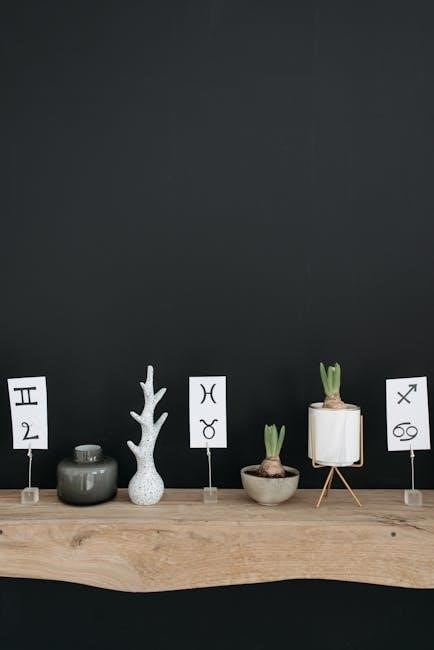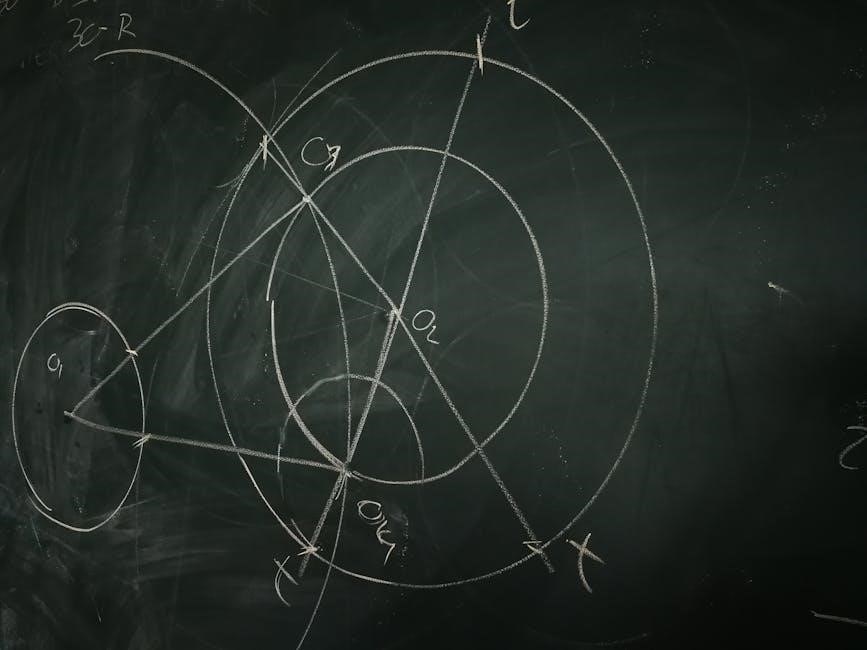Understanding Crock-Pot symbols is essential for optimal use. Symbols like “I” and “II” represent low and high settings‚ while others indicate keep warm or special functions. They guide users in operating the appliance effectively and safely.
Overview of Crock-Pot Symbols and Their Importance
Crock-Pot symbols are designed to simplify operation and ensure safe use. These symbols‚ such as “I” for low‚ “II” for high‚ and the keep warm indicator‚ guide users through cooking modes. They eliminate guesswork‚ making it easy to select the right setting for various recipes. Understanding these symbols is crucial for achieving desired results‚ as they indicate temperature levels and cooking durations. Additionally‚ safety symbols‚ like those for handling the lid or avoiding overheating‚ help prevent accidents. By familiarizing yourself with these icons‚ you can maximize your Crock-Pot’s functionality while maintaining safety and efficiency in the kitchen. These symbols are universal‚ making them accessible even to first-time users. They are a key feature that enhances the overall cooking experience with a Crock-Pot slow cooker.
Understanding the Basics of Crock-Pot Controls

The Crock-Pot control panel features symbols that indicate different cooking settings. The “I” and “II” symbols represent low and high temperature settings‚ respectively‚ while a wavy line symbol denotes the “keep warm” function. These controls are straightforward‚ allowing users to easily adjust cooking modes. Additional symbols may include indicators for sauté or pressure cooking functions‚ depending on the model. The dial or buttons are designed for intuitive operation‚ ensuring users can select the desired setting without confusion; Understanding these controls is fundamental for effective use of the Crock-Pot‚ as they directly impact cooking time and temperature. Proper use of these settings ensures food is cooked evenly and safely. Referencing the user manual can provide further clarity on specific symbols and their functions‚ enhancing the overall cooking experience.

Referring to the Crock-Pot User Manual
The Crock-Pot user manual is essential for understanding symbols and proper usage. It can be downloaded as a PDF and provides detailed explanations of all controls and functions.
How to Find and Use the Official Crock-Pot Manual
To find the official Crock-Pot manual‚ visit the manufacturer’s website and search for your specific model. Manuals are often available as downloadable PDFs. Once downloaded‚ open the file using a PDF viewer. The manual provides detailed instructions for understanding symbols‚ operating controls‚ and troubleshooting. It includes sections on cooking settings‚ safety precautions‚ and care tips. Use the table of contents or search function to quickly locate specific information. For models like the CR028‚ the manual offers clear explanations of features and symbols. Referencing the manual ensures proper use and maintenance of your Crock-Pot‚ helping you get the most out of its functions and extending its lifespan. Always consult the manual before attempting new settings or troubleshooting issues.
Common Symbols Explained in the Manual
The official Crock-Pot manual deciphers essential symbols for users. The “I” symbol represents the low setting‚ ideal for prolonged cooking‚ while “II” stands for high‚ suitable for quicker results. The wave symbol indicates the “Keep Warm” function‚ maintaining food temperature without overcooking. Other symbols may include a sauté mode for browning ingredients and a timer for setting specific cooking durations. Understanding these symbols ensures proper operation and enhances cooking outcomes. Each symbol is explained with clear visuals and descriptions‚ making it easy to navigate the appliance’s features. By familiarizing yourself with these symbols‚ you can utilize your Crock-Pot efficiently and safely‚ achieving desired results for various recipes and cooking methods. The manual serves as a comprehensive guide to decoding these symbols effectively.

Deciphering Crock-Pot Control Panel Symbols
Crock-Pot control panels feature symbols like “I” (low)‚ “II” (high)‚ and wave symbols (keep warm). These indicators help users understand settings and functions at a glance.
Understanding the Meaning of “I” and “II” on the Dial
The symbols “I” and “II” on your Crock-Pot dial represent the low and high temperature settings‚ respectively. These settings control the cooking time and heat level. “I” stands for low‚ which is ideal for longer‚ gentle cooking‚ while “II” stands for high‚ designed for faster cooking. These settings are crucial for achieving the perfect texture and flavor in your dishes. Proper use ensures even heating and prevents overcooking. Always refer to your manual for specific guidance on when to use each setting based on your recipe. Understanding these symbols helps you maximize your Crock-Pot’s versatility and efficiency in the kitchen.
Interpreting the “Keep Warm” Symbol
The “Keep Warm” symbol‚ often represented by three waves or a similar icon‚ indicates a setting designed to maintain food at a safe serving temperature. This feature is ideal for keeping dishes warm after cooking without overcooking them. It is especially useful for events or gatherings where food needs to stay ready-to-serve for an extended period. The “Keep Warm” function ensures that your meal remains at a consistent temperature‚ preventing bacterial growth and maintaining flavor. Always refer to your Crock-Pot manual for specific guidance on when and how to use this setting. Proper use of this symbol ensures your food stays delicious and safe to eat‚ making it a convenient option for busy households or entertaining guests.
Other Symbols and Their Functions
Beyond the basic settings‚ your Crock-Pot may feature additional symbols that enhance functionality. The sauté symbol‚ often denoted by a pan icon‚ allows for browning ingredients before slow cooking. A timer symbol indicates programmable cooking times‚ enabling precise control; Some models include a pressure cooker symbol‚ offering faster cooking options. Symbols like a lock or checkmark may signify lid locking mechanisms or completion of a cooking cycle. Other symbols might represent delay start or automatic shut-off features. Each symbol is designed to simplify cooking processes and ensure dishes are prepared to perfection. Consulting your manual will clarify the meaning of these symbols‚ helping you utilize all features effectively for a variety of recipes and cooking methods.

How to Use a Manual Crock-Pot Slow Cooker
Start by preparing ingredients‚ then set the cooker to low or high using the dial. Allow it to heat‚ cook‚ and keep warm as needed for perfect results.
Preparing for Use: Essential Steps
Before using your Crock-Pot‚ ensure all components are clean. Wash the lid and removable cooking bowl with warm soapy water and dry thoroughly. Place the cooker on a heat-resistant surface. Plug it into a nearby outlet‚ ensuring proper ventilation. Familiarize yourself with the control panel symbols‚ such as “I” for low and “II” for high settings. Prepare ingredients according to your recipe‚ chopping vegetables and seasoning meats as needed. Add the recommended liquid to avoid dry cooking; Fill the cooking bowl appropriately‚ leaving space for expansion. Secure the lid tightly to trap steam and heat. Always refer to the manual for specific model instructions to ensure safe and effective use.
- Wash and dry all parts before first use.
- Position the cooker on a stable‚ heat-resistant surface.
- Plug in the appliance and understand the symbols.
- Prepare ingredients and add liquids as required.
- Fill the bowl correctly and secure the lid.
- Refer to the manual for model-specific guidance.
These steps ensure safe and efficient cooking with your Crock-Pot.
Operating the Slow Cooker: Basic Guidelines
Once prepared‚ place ingredients in the cooking bowl and select the appropriate setting using the control panel symbols. “I” indicates low heat‚ while “II” represents high heat. Other symbols may include keep warm or specialized functions. Turn the dial to your desired setting‚ ensuring it aligns with your recipe’s requirements. Allow the cooker to heat up‚ which should take a few minutes. Avoid frequent lid lifting to maintain consistent heat. For models with timers‚ set the cooking duration as needed. Always refer to the manual for specific guidance‚ as settings may vary by model. Keep the cooker on a stable‚ heat-resistant surface and away from flammable materials. Regularly monitor progress to ensure optimal results.
- Select the appropriate heat setting (“I” for low‚ “II” for high).
- Set timers or durations based on your recipe.
- Avoid opening the lid excessively during cooking.
- Place the cooker on a heat-resistant surface.
- Monitor cooking progress for best results.
Care and Maintenance Tips

Proper care and maintenance are crucial for extending the life of your Crock-Pot. Always wash the removable cooking bowl and lid with warm soapy water before and after use. Avoid using abrasive cleaners to prevent scratching. For tough stains‚ soak the bowl in warm water before cleaning. Dry all parts thoroughly with a clean towel to prevent water spots. The tempered glass lid should be handled with care to avoid chipping or breaking. Regularly wipe the exterior and base with a damp cloth to remove splatters and spills. Never submerge the electrical base in water. Store the cooker on a heat-resistant surface‚ such as an insulating pad or trivet‚ to protect your countertop. Refer to the user manual for model-specific maintenance instructions to ensure optimal performance and longevity.
- Wash removable parts with warm‚ soapy water.
- Avoid abrasive cleaners and harsh chemicals.
- Dry components thoroughly after cleaning.
- Use a trivet or insulating pad for surface protection.
- Consult the manual for model-specific care tips.

Cooking Times and Temperature Settings

Crock-Pot low and high settings control cooking duration. Low cooks food slowly over 8-10 hours‚ while high cooks faster in 4-6 hours‚ ensuring tender results for various recipes.
Low vs. High Settings: What You Need to Know
The low and high settings on your Crock-Pot are designed to offer flexibility in cooking. The low setting is ideal for dishes that require a longer cooking time‚ typically between 8 to 10 hours‚ which is perfect for tougher cuts of meat or hearty stews. This setting ensures that flavors meld slowly‚ resulting in tender and flavorful dishes. On the other hand‚ the high setting is meant for quicker cooking‚ usually taking about 4 to 6 hours. It’s great for recipes where you want to achieve the same tenderness but in a shorter amount of time. By understanding these settings‚ you can choose the right option based on your schedule and the type of meal you’re preparing. This feature allows you to customize your cooking experience‚ making the Crock-Pot a versatile tool in the kitchen.
Understanding the Cook Time and Pressure Levels
Cook time and pressure levels are crucial for achieving the best results with your Crock-Pot. The low setting typically cooks food over 8-10 hours‚ ideal for tougher meats and stews‚ while the high setting reduces cooking time to 4-6 hours. Pressure levels‚ though more common in pressure cookers‚ are indicated by symbols like “I” (low) and “II” (high). These settings help regulate heat and ensure even cooking. Some models feature pre-set times for specific dishes‚ such as meat‚ beans‚ or rice. Understanding these symbols allows you to adjust cooking times and pressures accurately. Always refer to your manual for model-specific guidance‚ as symbols and settings may vary. Proper use of these features ensures your dishes are perfectly cooked every time‚ whether you’re preparing a hearty stew or a delicate dessert.

Safety Precautions When Using a Crock-Pot
Always handle the lid with care to avoid burns. Use oven mitts when lifting or moving the cooker. Place it on a heat-resistant surface and keep children away.
Important Safety Tips for Proper Use
Always place your Crock-Pot on a heat-resistant surface to prevent damage. Use oven mitts or tongs to handle the hot lid and cooking bowl. Avoid touching the cooker’s base or handles during operation. Keep children and pets away from the appliance while it is in use. Never leave the Crock-Pot unattended when it is turned on; Ensure the lid is securely closed to avoid splatters and spills. Regularly inspect the power cord for damage and avoid overloading electrical outlets. Follow the manufacturer’s guidelines for cleaning and maintenance. Allow the cooker to cool down before washing or storing it. By adhering to these safety tips‚ you can enjoy safe and hassle-free cooking with your Crock-Pot.
Handling the Lid and Cooking Bowl Safely
Always use oven mitts or tongs to handle the hot lid and cooking bowl to prevent burns. Place the lid securely on a heat-resistant surface when removed. Avoid using abrasive cleaners to prevent damage to the non-stick coating. Regularly inspect for chips or cracks and store them in a dry place. Never put the lid or bowl in the dishwasher. For specific care instructions‚ refer to the Crock-Pot manual. Proper handling ensures longevity and safety.

Troubleshooting Common Issues
Common issues include error symbols appearing or the lid not fitting properly. Check for loose connections‚ ensure proper alignment‚ and refer to the manual for error code meanings. Resetting the unit often resolves issues.
Identifying and Solving Common Problems
One common issue is when the Crock-Pot doesn’t heat up. This could be due to a faulty power cord or incorrect settings. Check if the unit is properly plugged in and ensure the dial is set to “Low” or “High.” If the lid doesn’t fit‚ ensure it’s aligned correctly and free from obstructions. Error symbols‚ like flashing lights‚ often indicate issues like overheating or a faulty sensor. Refer to the manual for specific error codes. Another issue is uneven cooking‚ which can be resolved by stirring the contents or adjusting the cooking time. Regular cleaning of the crock and lid can prevent residue buildup that might affect performance. Always unplug the unit before attempting any troubleshooting steps to ensure safety. By addressing these common problems‚ you can maintain your Crock-Pot’s efficiency and extend its lifespan.
Understanding Error Symbols and Indicators
Crock-Pot error symbols and indicators are crucial for diagnosing issues. Common errors include overheating‚ indicated by flashing lights or specific codes‚ and sensor malfunctions‚ which may display “E” or “Err.” These symbols signal problems like improper lid alignment or faulty temperature sensors. If the unit fails to heat‚ check for power issues or incorrect settings. Some models show codes like “E1” for sensor errors or “E2” for overheating. Refer to the manual for code meanings‚ as they vary by model. Resetting the unit or unplugging it for a few minutes often resolves minor glitches. Always ensure the lid is sealed properly and the crock is clean to prevent errors. If issues persist‚ contact customer support for assistance. Understanding these indicators helps maintain your Crock-Pot’s performance and longevity.
Understanding Crock-Pot symbols ensures safe and effective use. Familiarize yourself with settings like “I” (low) and “II” (high)‚ and always refer to the manual for clarity and troubleshooting.
To effectively use your Crock-Pot‚ understanding its symbols is crucial. The “I” and “II” settings correspond to low and high temperatures‚ respectively‚ while the wavy symbol indicates the keep-warm feature. Always refer to the user manual for detailed explanations of these and other symbols‚ ensuring safe and optimal operation. Proper care‚ such as cleaning the lid and bowl‚ and maintaining the appliance on a heat-resistant surface‚ prolongs its lifespan. Additionally‚ familiarizing yourself with troubleshooting tips helps resolve common issues. By following these guidelines‚ you can maximize your Crock-Pot’s performance and enjoy delicious‚ hassle-free meals.
